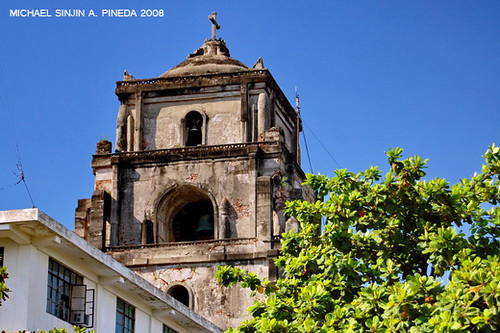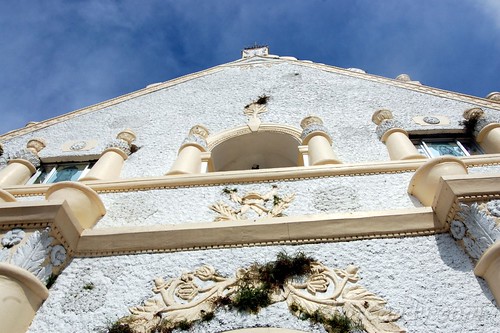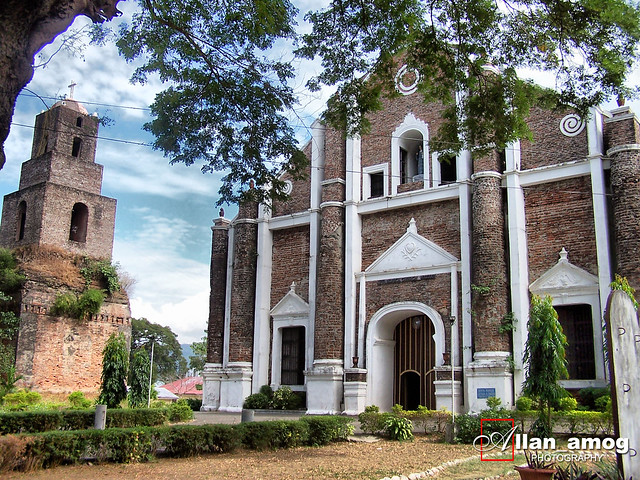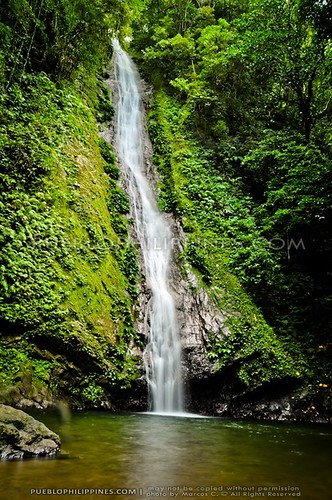And so after all the stress
of the past few weeks, Tita Susan, Tito Efren and I have decided to go on a
little four-day vacation to Laoag, Vigan, and the surrounding areas (with Jem
and Shayne, of course). It was actually supposed to be a solo trip for me, and
then with Tita Susan, but Tito Efren and the others decided to tag along. So
anyway, I worked on our itinerary yesterday, and I must say, the Ilocos
provinces: WOW. They’re blessed with some of the best natural scenery and
man-made architectural gems. No wonder they’re so proud of their heritage. I
would be too.
Anyhow, in case it will
help anyone trying to plan a trip there, I’m sharing our itinerary and a little
FYI pamphlet I prepared for the oldies, for a bit of historical background. I’ll
add pictures later kung sipagin ako.
NOTE: I did not write the
historical background part. I just edited some parts for grammar of clarity. Well, I'm in the process of editing. Most of it, I borrowed from http://www.worldtourist.us/ilocosnorte/laoag.html.
The rest, I compiled from the following websites. (This is a post-compilation
best-efforts list. If I missed anything, please let me know.)
Anywaaaaaaaaaaayyy…
ITINERARY FOR ILOCOS TRIP
7:55 pm – ETD
MNL-LAO flight (5J-404)
9:00 pm – ETA Laoag
NOTE:
Morning activities optional.
8:00 am – Breakfast
at Saramsam Cafe
9:00 am –
Museo Ilocos Norte (Php20 entrance fee) / Ilocos Norte Capitol
10:00 am - St.
William’s Cathedral / Sinking Bell Tower
11:00 am - Balay da Blas (Wait for Tita Susan
et.al.)
12:00 nn - Lunch
at Saramsam Café
1:00 pm - St.
William’s Cathedral / Sinking Bell Tower
2:00 pm - Museo Ilocos Norte / Ilocos Norte
Capitol / Tobacco Monopoly Monument
3:00 pm - Sarrat
(15 mins east of Laoag) – Sta. Monica Church
4:30 pm - La Laz
Sand Dunes (20 mins west of Laoag)
6:00 pm - Dinner at
Fort Ilocandia
Driving directions: Follow the main
road and make a left on the airport road, proceed until you see the Northwestern University on your right.
Make a left on the road in front of the University, and make a right towards
the entrance to Fort Ilocandia Resort.
8:00 pm - ETA Balay da Blas
7:00 am -
Breakfast at Balay da Blas
8:00 am - ETD Balay da Blas
(En route: Patapat Viaduct)
9:30 am - Pagudpud (until lunchtime) (1.5 –
2 hours from Laoag) – Saud Beach
12:00 nn -
ETD Pagudpud
12:30 pm -
Paraiso ni Anton (running waters through a lush green forest leading to a
statue of the Virgin Mary)
- Maira-Ira Beach (“Blue Lagoon”) –
Sitio Gaoa, Balaoi, Pagudpud
- Timmangtang
Rock (U-turn, right on smaller road; male rock)
- Bantay-AbotCave (female rock)
- Collectively
called lovers’ rock
- Dos Hermanos
- Kaibigan Falls (optional; 30
minute trek)
- Bangui Windmills
(1.5 hours from Laoag, 30 mins from Pagudpud)
- Kapurpurawan Rock
Formation
- Cape Bojeador Lighthouse (40km
northeast of Laoag) – 30
- Pasuquin Saltmakers (optional)
- Bacarra Church and Bell Tower
Ruins (15 mins from Laoag)
6:00 pm - Dinner at La Preciosa (Rizal St., Laoag City, Ilocos Norte, 2900)
Tel.: (+6377) 773-1162 / 2159
8:00 pm - ETA Balay da Blas
6:00 pm - Dinner at La Preciosa (Rizal St., Laoag City, Ilocos Norte, 2900)
Tel.: (+6377) 773-1162 / 2159
8:00 pm -
ETA Balay da Blas
7:00 am - Breakfast at Balay da Blas
8:00 am - ETD Balay da
Blas
9:30 am - Bantay Church (town before
Vigan)
11:00 am - Baroque Church
of Sta. Maria (3 hours from Laoag)
12:00 nn -
ETA Vigan (1.5 to 2 hours from Laoag) – Lunch at Café Leona (Calle Crisologo - Vigan City, Ilocos Sur; +63 (77)722-2212)
1:00 pm - Calle Crisologo / Crisologo House /
Syquia Mansion / Quema House / V. Singson Encarnacion House / Grandpa’s Inn
4:00 pm
- St. Paul’s Metropolitan Cathedral
5:00 pm -
Burgos National Museum
7:00 pm -
Dinner at Hidden Garden / Lilong & Lilang Coffee Shop (Brgy. Bulala Centro,
Vigan City; (63)(77) 722-1450; Francis Flores, owner,
0921-664-0737
10:00 pm -
ETA Balay da Blas
Other places we
can go:
·
Chavit’s Baluarte Zoo
·
Burnayan (pottery)
·
Plaza Salcedo
·
Plaza Burgos
8:00 am - Breakfast at Balay da Blas – Don’t
forget to check out!!!
9:30 am - ETA Paoay (15-20 mins from Laoag)
·
Malacañang of the North
·
Paoay Lake
·
Paoay Church
12:00 nn -
Lunch at Herencia Café – in front of Paoay Church (McArthur
Street, Bgy. 14, Paoay, Luzon, Philippines; 077- 614 -0214)
1:30 pm -
Batac – Marcos Museum
3:00 pm -
Currimao – Nipa Beach Hut Resort
5:00 pm - Badoc – Juan Luna
Shrine
- Badoc - La Virgen Milagrosa Shrine
6:00 pm - ETA Balay da Blas
7:00 pm -
Leave for airport
9:30 pm -
ETD LAO-MNL (5J-405)
THE PROVINCE OF ILOCOS NORTE
Ilocos Norte is
located on the northernmost edge of western Luzon. Its
boundaries are formed by the Babuyan Channel on the north and its sister
province, Ilocos Norte, on the south. To the west are the tribulent waters of
the South China Sea, while the
eastern borders are formed by part of the Cagayan Valley, Abra and the Mountain Province. A well-paved
coastal highway connects the province with the rest of the country.
Ilocos Norte
has a total land area of 3,400 square kilometers. It is composed of 22
municipalities with 477 barangays. The province's population was 514,000 by the
census of 2000, and since 1999 its governor is Ferdinand R. Marcos, Jr. It was
made a separate province in 1818. The province is noted for being the
birthplace of former Philippine President Ferdinand E. Marcos, who led an
authoritarian rule over the country during the later half of his incumbency.
Ilocos Norte has always been Marcos territory and the family enjoy a moderate
amount of popularity in the province. Even before one reaches the capital,
traces of the "great Ilocano" are unmistakable.
Long before the
Spanish galleons came to the Philippines, the coastal
plane of Ilocos Norte was already flourishing with business carried out by the
Chinese and Japanese traders. The first Spaniards to reach the region were Juan
de Salcedo and his men, who were tasked to explore the coast of Luzon north of Manila in 1572. The
largest concentration of people that Salcedo found was in Laoag along the Padian River, and Salcedo
gained their friendship after initial skirmishes. Although the presence of the
Spanish soldiers may have seemed fleeting to the Ilocanos, Salcedo's
exploration marked the beginning of Spanish colonization of the region.
Agriculture is
the main source of livelihood in the province, all lands for cultivation can be
planted with rice, corn, garlic, onion, sugarcane, tobacco, and cotton. Ilocos
Norte is also noted for its various cottage industries, among which are cloth
weaving, pottery-making, blacksmithing, woodcarving and furniture making. Its
ethnic population is overwhelmingly Ilocano. Unlike the rest of the region,
however, the Roman Catholic Church does not predominate. The Aglipayan Church, Iglesia ni
Cristo, and other Protestant groups have strong followings, as well as, animism
and non-religiosity. The climate is characterized by two extremes: very dry
from December to April and very wet for the rest of the year. The average
temperature in Ilocos Norte is 81 deg F. May is the warmest month, with an
average temperature of 83 deg F, and December is the coldest.
Laoag City
Laoag City, the capital city
of Ilocos Norte, is 463
kilometers north of Manila. The
municipalities of San Nicolas, Paoay, Sarrat, Vintar, and Bacarra form its
boundaries. The foothills of the Cordillera Central mountain range
to the east, and the South China Sea to the west
are its physical boundaries. Flourishing along the bank of the Laoag River, it is the
nerve center of the province and the seat of politics, business, commerce,
education and religion. It became a 2nd class city in 1965. According to the
2000 census, it has a population of 94,466 people in 19,751 households.
"Laoag"
(Ilocano for "the place of light or clarity"), is an old, flourishing
settlement known to Chinese and Japanese traders when the Spanish conquistador
Juan de Salcedo arrived at the northern banks of Padsan River in 1572.
Augustinian missionaries established the Roman Catholic Church in the area in
1580 and designated Saint William, the Hermit as its patron saint. Pedro
Almazan crowned himself king of Laoag in 1661 in a bid of insurrection and
protest against Spanish tax mandates. Other rebellions flared throughout
colonial times, including against Spanish tobacco monopoly in 1782.
Laoag is an 9
to 10 hour drive from Manila depending on
the traffic or how fast you are going. Provincial buses also provide
transportation from Baguio City, Manila, and a number
of other cities. There are air-conditioned buses that leave their Manila stations for
Laoag. The buses, which leave on scheduled runs, do stopovers at designated
points along the route for refreshments and other necessities. Laoag International Airport services
flights to and from Taiwan and some
charter flights by Philippine carriers. It is a 1 hour flight from Manila. The town
experiences the prevailing monsoon climate of Northern Luzon, characterized
by a dry season from November to April and a wet season from May to October,
occasionally visited by powerful typhoons.
The Landmarks & Attractions of Ilocos Norte
- Juan Luna Shrine
- Fort Ilocandia Resort Hotel
- Paoay Church
- Marcos Mausoleum and Museum
- St. William's Cathedral
& Sinking Bell Tower
- Museo Ilocos Norte
- Bacarra Church
& Bell Tower Ruins
- Malacanang of the North
- Salt Making in Pasuquin
- La Virgin Milagrosa Shrine
of Badoc
- Currimao's Nipa Beach Resort
- Sarrat's Sta. Monica Church
 |
| http://media-cdn.tripadvisor.com/media/photo-s/01/d5/30/6b/museo-ilocos-norte.jpg |
MUSEO
ILOCOS NORTE
Located in the downtown
area of Laoag City and just close to the provincial
capitol and about a block away from the town plaza is the Museo Ilocos Norte.
One of the best ways to get to know Ilocano culture is by visiting the museum.
The museum is housed in the restored historic Tabacalera warehouse, which was a
factory of sorts for tabacco back in the Spanish Era. The museum was primarily
designed to bring a sense of pride to the citizens of the province. It
showcases the varied ethnicity and multi-faceted cultural heritage of the
Ilocano people. It is one of the few attractions in Laoag City which is most visited by school
children, visitors, and tourists.
The museum is nicknamed,
"Gameng," from the Iloco word meaning treasure. It symbolizes the
wealth of Ilocos Norte. There is an assortment of items displayed on both
floors of the two-storey building. Before you exit out of the museum, you will
find a small giftshop which sells an assortment of native products and
handicraft of Ilocos Norte, and a few books and other publications written
about the province. There is a minimal fee charged to view the contents of
Museo Ilocos Norte. The museum is opened during office hours in the morning and
afternoon of the work week, however, it is closed at noon time which allows it's staff time
for their lunch break. The symbol of the museum, a many-rayed sun, was taken
from one of the finials at the back of the 19th century church in San Nicolas.
 |
| http://farm5.static.flickr.com/4030/4674605725_eb27b0c98f.jpg |
 |
| http://farm5.static.flickr.com/4070/4632596272_c6a2d68512.jpg |
ST. WILLIAM'S
CATHEDRAL & SINKING BELL TOWER
A chapel of wood and thatch
was originally built on the same site when the Augustinian Friars founded the
parish in 1580. Later in 1612, foundation for the replacement of the church was
laid by the friars and construction of the cathedral with Italian Renaissance
design began. The church was damaged by fire in 1843 and repaired through the
efforts of the Obras Publicas under the supervision of Engr. Antonio
de la Camara and Fray Santiago Muniz from 1873 to 1880.
The reconstructed church
has a unique two-storey facade held by four pairs of coupled columns and was
called the St. William's Cathedral. The deeply recessed niche shows the image
of Saint San Guillermo. It is the one of the biggest cathedrals in the country
and became the seat of the Diocese of Laoag. In 1898 it was occupied by
Revolutionarists and also by the American forces in 1899. The cathedral was the
site of the Diocesan Congress in 1932 and 1949.
Located 85 meters away is
its bell tower which has sunk to the grounds and leans slightly. The 45 meter
high bell tower is one of the tallest edifice built in the province. When the
tower was newly erected a person on horseback can pass through its door freely.
Today, a person of average height could hardly pass without stooping.
 |
| http://farm6.static.flickr.com/5087/5288952216_eeeabcd38c.jpg |
 |
| https://blogger.googleusercontent.com/img/b/R29vZ2xl/AVvXsEgEQqzqLBwDByLWby2C_Uu6zdYy5q0x7AdJ1K-bezvx_t3uoekNaFHS-ABcTM8y3GPAVznPsQydPCVls1g7ZE9rbeXXXqfC6O4Cd6ZAtIiehexfz4FWTAIGmgWUeuvG9hhb-bjG/s1600/aurora%252Bpark%252Blaoag%252Bcity%252Btobacco%252Bmonopoly%252Bmonument%252Bilocos%252Btour.jpg |
TOBACCO MONOPOLY MONUMENT
When the Spaniards
discovered that the land and climate of Ilocos is perfect for growing tobacco,
they forced the people to plant only tobacco and no other crop. The sakadas
were also forced to sell the tobacco leaves only to the Spanish government.
This has lead to numerous resistance among the locals. There were also stories
of untold abuses done by the authorities. For one hundred long years, 1781
until 1881, the tobacco monopoly existed in Ilocos. A period of dark history in
Ilocandia.
It was only in 1881 when King Alfonso XII lifted the tobacco monopoly. The
people of Ilocos then erected the Tobacco Monopoly Momunent as a thanksgiving
to the Crown of Spain for recognizing the stuggles of the Ilocano people
against the Monopoly.
The tall yet graceful monument is located right at the center of Laoag City plaza, in front of the Provincial
Capitol.
 |
| http://farm4.staticflickr.com/3480/3212135856_d8ff6efa50_z.jpg |
SARRAT'S STA. MONICA
CHURCH
In the town of Sarrat is a beautiful red brick church of Baroque and Neo-Classical style called the
Sta. Monica Church. Irene Marcos, the daughter of former Philippine President
Marcos, was married to Gregorio Araneta in a fairytale-like wedding in the
church complete with red carpet stretching for kilometers. In the Philippines, it was termed the "wedding of
the century." However, a little more than two months later, on Aug. 17, an
earthquake of Intensity 7.6 ravaged Ilocos Norte and destroyed the altar and
belfry of Sta. Monica.
The church is located some
7 kilometers to the east of Laoag City proper. It is an all-brick church
with buttressed walls and a 3-level brick bridge and staircase connects the
church to the convent making it one of the unique features of this church. The
Sta. Monica Church, convent and bell tower began construction in 1669 and were
completed in 1679. Rebuilt after a fire in 1817, the complex was again damaged
by fire in 1882 but was rebuilt and finished in June 1896. The church features
a 137-meter nave that is the longest in the country, according to the Cultural Center of the Philippines’ Encyclopedia of Philippine Art. It
follows a simple rectangular plan and another outstanding feature of the church
is its unique system of roof trusses.
Like the bell tower, the
convent stands apart from the church. Separate towers and rectories are
characteristic of the province, a measure to minimize damage during
earthquakes. At the ground level of the convent are housed memorabilia, books
and photographs connected with the history of the parish. The ruins of Sta.
Monica Church in Sarrat include a torture room where two huge brick-encrusted
pillars dominate. Melvin dela Cuesta, a Filipino historian, said these pillars
were used during the Spanish regime to hang Filipinos accused of treason and
other high crimes.
 |
| https://blogger.googleusercontent.com/img/b/R29vZ2xl/AVvXsEig8pqtUmgInZ485_PW3fT317RZj4X6GSE8tyRgmlXNrC9D-7ZlyfqiJNxeENyWFrVCyFgvkvbqruT1yj5zmI9o4DGqHjkCiDPckMXmsIIofsi2MLgbVwOEzaR2SHIBHQr54gkTHw/s1600/sanddunes_laoagcity.jpg |
La Paz Sand
Dunes is a unique attraction in the city of Laoag for being a
sandy coastal desert with an area of 85 square kilometers. This is considered
to be a National Geological Monument because of its
uniqueness being a desert environment. La Paz is just a part
of a long stretch of the Ilocos Norte Sand Dunes. It spans from Currimao to
Pasuquin. This is locally called Bantay Bimmaboy in which they perceive that
the dunes resemble the shape of pigs.
The sand
dunes were formed by the interaction of the wind, sea and river that together
cause erosion and deposition. The height of the sand dunes ranges from 10-30
meters. Its pretty amazing to see this from a horizon with the South China Sea. There are exciting activities that
can be done here aside from trekking for an hour to traverse the entire stretch
of the beach, one can drive a rugged 4-wheel vehicle or the exciting
all-terrain vehicle. The latest craze is the sand boarding where one can use a
board to slide down the dunes. This site is accessible by tricycle and jeepney
and its just 15 minutes away from the city proper.
With these
activities, one can call it a desert safari just like what I had experienced
from Dubai. This was my visit to the site just right after arriving
from the Middle
East in
which I hosted a Canadian friend’s visit to Ilocos. I took Romeo here to
experience the desert. I did not fail, he truly enjoyed it. He ran, jumped and
climbed the sand dunes on bare foot feeling the heat underneath.
This is another world class treasure of Ilocandia. It was used to be a shooting
site for several local and international films. Himala and Panday are the
classic local movies that were shot here. And of course segments of the Hollywood films such as Mad Max and Born on
the fourth of July where Tom Cruise had a fight scene and rolled over the sand
dunes.
 |
| https://blogger.googleusercontent.com/img/b/R29vZ2xl/AVvXsEglRMz5W9gilkC87E8oJegoy_6oE6IGUlweYBOXBtj8-jUxQCQDN0eZZAuownueWMK99NuFjCvURSNNci1iyOmrIwFbB7Kqm7xA59s5PehsCK_TfhXzevfNxeO4yRkaLuyPwtkg/s1600/IMG_2826.jpg |
 |
| http://media-cdn.tripadvisor.com/media/photo-s/01/c6/52/e7/one-of-fort-ilocandia.jpg |
FORT ILOCANDIA RESORT HOTEL
The resort is located in
Barangay 37, Calayab, and about 9 kilometers from Laoag City. It is the only first class
property of its kind in the province of Ilocos Norte. The hotel is sprawled over 77
hectares of land at the middle of sand dunes, prime forests, and two kilometers
of fine sandy beach facing the South China Sea. It is situated on the
northwestern tip of the island of Luzon. Laoag City and Laoag International Airport are accessible by a 10-minute ride
from the hotel.
The Fort Ilocandia Resort
complex is composed of 5 buildings all inspired by Spanish colonial
architecture and finished in coal red bricks. It has guest rooms with private
balconies offering a panoramic view of the sea. These rooms have features and
qualities of Ilocano century-old living quarters and constructed to accentuate
the antiquity of a colonial house.
The main building houses
the lobby, a number of restaurants, shopping arcade, casino, discotheque, and a
glass-topped atrium where you can relax as you sip your favorite drinks, tea or
coffee. For those who love Asian cuisines, Lucky House and Golden Pavilion are
the best places to dine. It offers the finest Cantonese dishes and one can find
delicious dishes from Korea, Japan and Taiwan. At the Sunset Bar which is located
at the beachside you can have a drink and after which you can dine in a Spanish
Restaurant, or CoCo Lobster where you can enjoy authentic Filipino cuisine.
After your dinner, you can visit the Casino Filipino at the second floor. It is
open 24 hours a day with multi-lingual attendants. The gaming area includes
more VIP game rooms to satisfy your appetite for thrill. At the Passion Night
Club and Karaoke glamorous shows are held every night. There are VIP rooms
where guests can show their singing prowess or none of it, and have a fun and
relaxing time.
Hotel
facilities of Fort Ilocandia include an Olympic-sized swimming pool, seven
function rooms, video arcade, tennis court, badminton court, gym and sauna,
driving range, golf course, paintball, beach volleyball, jet ski, sea donut,
wind glides, sailing boat, bodyboard and pool toys. The guests may also indulge
in various recreational activities such as wind sailing, archery, shooting,
horseback riding, wind gliding/wind surfing, canoeing, open sea fishing,
snorkel diving, scuba diving, and rafting, among others. The resort also has a
world-class 18-hole golf course with international standards and a perfect
design to challenge one's playing skills. The golf course, with numerous trees
built along Lake Paoay was designed
by PGA champion, Gary Player for the late President Marcos. It measures 6,518
yards from the blue tee with a par of 72. Added hazards are the century-old
fruit bearing trees and man-made ponds and lake.
The hotel's red
brick facade and roofs beautifully contrast with white round windows. Clearly,
it's inspired by the architecture of the colonial Spanish or Spanish Moroccan
style. There is an impressive and immense fountain and well-maintained gardens
and flowering plants-lined walkways. The rooms that spread out in four other
two-storey buildings include 233 standard rooms; 25 deluxe rooms; eight junior
suites; and two presidential suites. All of them have aircon units, cable tv,
telephones, and a bathroom with hot water. Fort Ilocandia Resort is without
doubt one of the most interesting places in northern Luzon and is perfect
for pleasure seekers because of its distinctive and naturalistic appeal.
 |
| https://blogger.googleusercontent.com/img/b/R29vZ2xl/AVvXsEhBfRO36V0Fqbr9lg20MKE0OzsIt74bAEj-3Z8EtHKgSQ6PBSJn5TzpGpEt8l2JtbrB-7vMLmvZZShpwn_BhopysAQlG0vJOw9oLVFd_lHa-LT8sWRyDkde7zEpFDxQYjORjxiD/s320/Patapat+Viaduct+Pagudpud+Ilocos+Norte+B.jpg |
PATAPAT VIADUCT
The Patapat viaduct is considered as the 4th longest bridge in the Philippines and the second
northermost road of the island of Luzon. It is like a
winding bridge beside the cliffs of the Cordillera Mountain Range It is about
1.5 kilometers long and elevated around 30 M above the sea. It connects the Maharlika
Highway to Cagayan province. It was built for
the purpose of minimizing landslide. Other buses bound to other northernmost
province of the Philippines take this
route.
Also called as the “French Riviera of the North” for this magnificent coastal
drive. You can just park your vehicle and take photos of the vast northern blue
sea and flying birds along the coast. Like what we did on our way to Paraiso ni
Anton. You shouldn't miss the opportunity to witness the view of the south
china sea waves that hit big rocks which was indeed breathtaking.
 |
| Saud Beach - http://lh5.ggpht.com/_bJKz4lWVpfo/TUcJ9c6wIKI/AAAAAAAAElU/nflPOcfvlFA/Saud%20Beach%20in%20Pagudpud,%20Ilocos%20Norte%20-%20JustAnotherPixel.net%5B2%5D.jpg |
|
 |
| Maira-Ira Beach / "Blue Lagoon" - http://www.thinkphilippines.com/pictures/blue-lagoon-maira-ira-beach-philippines.jpg |
 |
| Timmangtang Rock Formation - http://farm6.static.flickr.com/5174/5525782508_a3b0e2539e_o.jpg |
 |
| Bantay-Abot Cave - http://manilenio.com/wp-content/uploads/2011/10/Bantay-Abot-Cave-Ilocos-Norte.png |
 |
| Dos Hermanos Islets - https://blogger.googleusercontent.com/img/b/R29vZ2xl/AVvXsEgHApAUfpOPQbU1ZeWdDvh0ePF_R6nj2FeMlJmyKeECXCaWkqEp6aF8D9KNzH1nLn-SheznWgp94pXuASiomWlAISmTonrX005OK8FPzBsFdyuQHSX9IQ6_3FBBmkduMpMq8CMe/s1600/P1110449.JPG |
 |
| Kaibigan Falls - http://farm6.static.flickr.com/5090/5288310083_30a778ae40.jpg |
PAGUDPUD
Pagudpud, a town situated 1 and a half hours north of Laoag
City, the provincial capital of Ilocos Norte, and about 10 hours by land from
the Philippine capital Manila, is fast gaining fame in the international travel
circuit staking its claim amongst the pretenders to the throne of having the
best Philippine beach which unarguably is perennially held by Boracay in Aklan.
But Boracay it is not, although it comes pretty close when it comes to sand
quality, the clarity of its stunningly blue waters and the length and width of
its beaches (other beaches in the Philippines do have white sand, but not as fine
nor the beach as long nor wide). But whilst Boracay caters to the to the party
scene and its extensive range of island activities, Pagudpud derives its charm
from exactly the opposite of that – even on a long weekend, the beaches of
Maira-ira, Saud and Pansian rarely get the hordes of tourists that Boracay,
Panglao (Bohol), and Puerto Galera (Oriental Mindoro) due to the town’s
relative remoteness (although Easter Weekend is an apparent exception as told
by our Korong-korong driver where the road to Maira-ira can get pretty clogged
with traffic).















